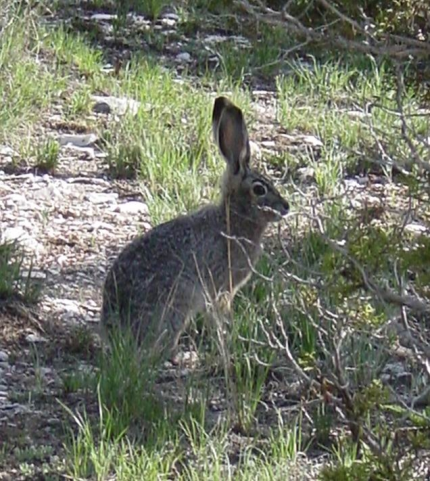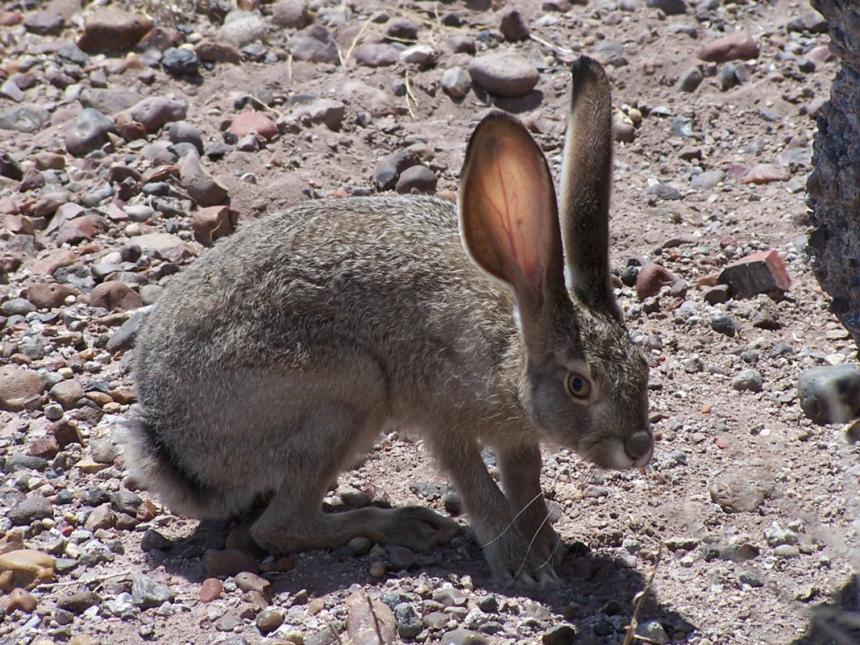Moderate
The population size of black-tailed jackrabbits in Washington is low. This species is vulnerable to loss of habitat connectivity from all four major connectivity threats: clearing and vegetation removal, development, roads and traffic, and the presence of people and domestic animals. Additionally, they are at considerable risk for increased mortality from vehicle traffic, persecution, and harassment by pets. Population monitoring is a challenge as no reliable census method exists for all population levels.
Description and Range
Physical description
An adult black-tailed jackrabbit is approximately 24 inches long and weighs between 3 and 6 pounds.
Ecology and life history
In central Washington, east of the Cascade Mountains, black-tailed jackrabbit distribution is concentrated in the semi-arid Columbia Plateau shrubsteppe and grassland habitats, and extends south into Oregon. Areas used include sagebrush and rabbitbrush (Chrysothamnus sp.) dominated habitats, as well as areas of mixed grassland and shrub. Black-tailed jackrabbits tend to occupy areas with more shrubs and less grass than white-tailed jackrabbits.

The black-tailed jackrabbit is one of three species of hare in Washington. The other two are the white-tailed jackrabbit and snowshoe hare. Hares differ from rabbits in that young are born fully furred with their eyes open, and they can hop within hours of their birth.
Black-tailed jackrabbits are generally nocturnal and solitary. Like white-tailed jackrabbits, around daylight they retire to resting sites in taller vegetation.
Predators known to prey on black-tailed jackrabbits include coyotes, badgers, bobcats, golden eagles, several species of hawk, owls, rattlesnakes, and gopher snakes.
The rabbit's diet varies seasonally, consisting of a higher percentage of shrubs in winter, “forbs” (non-woody flowering plants) in spring, and mostly grasses with almost no shrub ingestion in summer.
Black-tailed jackrabbits produce about 10 to 12 young annually, giving birth to multiple litters during a three-month breeding season. Only 3.5 to 9 percent survive to 1 year of age.
Geographic range
The black-tailed jackrabbit is the most common jackrabbit in the western U.S. Its range extends from southern-central Washington to South Dakota and southward into Baja California and well into south-central Mexico. They also have been successfully introduced into various eastern states.
Black-tailed jackrabbits were not present in Washington in the early 19th century. They first appeared in Washington in Walla Walla County around 1870. They spread north to the Snake River, and beyond it when the Snake River froze over around 1908. They spread across Benton County after the Columbia River froze in 1920. Black-tailed jackrabbits had occupied most of the Columbia Basin by 1930.
For a map of range-wide distribution and conservation status, check out NatureServe Explorer.
Climate vulnerability
Sensitivity to climate change
Moderate
The black-tailed jackrabbit occupies habitats with a wide temperature range and minimal moisture levels (e.g., shrub-steppe, grassland, desert), with presence of some shrub cover being an important habitat feature. This species is highly capable of thermoregulating and conserving water. This species is sensitive to some disturbance regimes, such as wildfire, which can remove shrubby vegetation that provides thermal, protective, and nesting cover and food plants. Warmer temperatures and changes in precipitation are projected to occur in Washington’s Columbia Basin, which will likely lead to more frequent and intense fires. These will eliminate or reduce important sagebrush habitat for jackrabbits and cause increases in cheatgrass and other invasive plants that have reduced forage value.
Exposure to climate change
Moderate
- Altered fire regimes
- Changes in wind
- Increased invasive plants
Conservation
Conservation Threats and Actions Needed
- Fish and wildlife habitat loss or degradation
- Threat: Habitat loss and degradation of shrubsteppe and grasslands due to historic unsustainable grazing practices and invasion of exotic plants.
- Action Needed: Conserve existing and restore degraded shrubsteppe and grassland habitats to provide necessary cover and food resources.
- Threat: Conversion of grasslands and shrubsteppe to cropland.
- Action Needed: Conserve existing and restore degraded shrubsteppe and grassland habitats affected by agriculture to provide necessary cover and food resources. Private landowner incentives such as U.S. Department of Agriculture Conservation Reserve Program would be an example of beneficial habitat management.
- Small population size
- Threat: The species now only occupies a small portion of its historic range in the state and small subpopulations may be susceptible to local extinction.
- Action Needed: Determine potential need and feasibility of reintroductions or augmentations to boost population.
- Disease
- Threat: Disease may have contributed to population declines
- Action Needed: Assess potential for Tularemia as a factor contributing to population decline. A new threat, Rabbit Hemorrhagic Disease (RHDV2), is a virus that has estimated 90% mortality rate and no cure for jackrabbits.
- Overharvesting of biological resources
- Threat: Control of black-tailed jackrabbits through shooting, poisoning, and trapping may be a contributor to population declines
- Action Needed: Assess current levels of mortality due to these practices and take steps to minimize lethal control.
- Resource information collection needs
- Threat: Quantitative data on distribution and abundance are lacking.
- Action Needed: Determine and map distribution; investigate cause of declines.
See the Climate vulnerability section for information about the threats posed by climate change to this species.
Resources
References
Best, T. L. 1996. Lepus californicus. Mammalian Species 530:1-10.
Flinders, J. T. and J. A. Chapman. 2003. Black-tailed jackrabbit. Pp 126-146 in G. A. Feldhamer, B. C. Thompson, and J. A. Chapman, editors. Wild mammals of North America biology management and conservation, 2nd edition. Johns Hopkins University Press, Baltimore, Maryland
